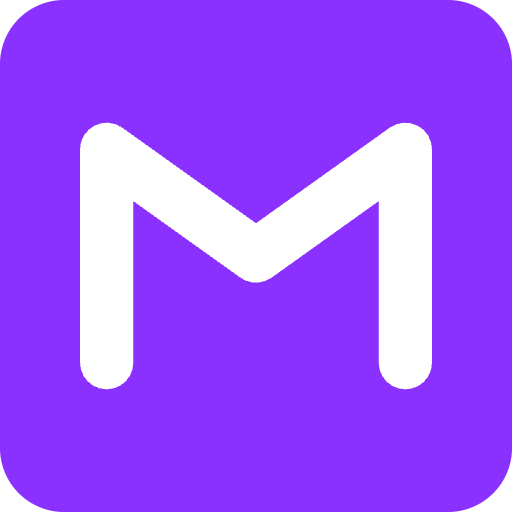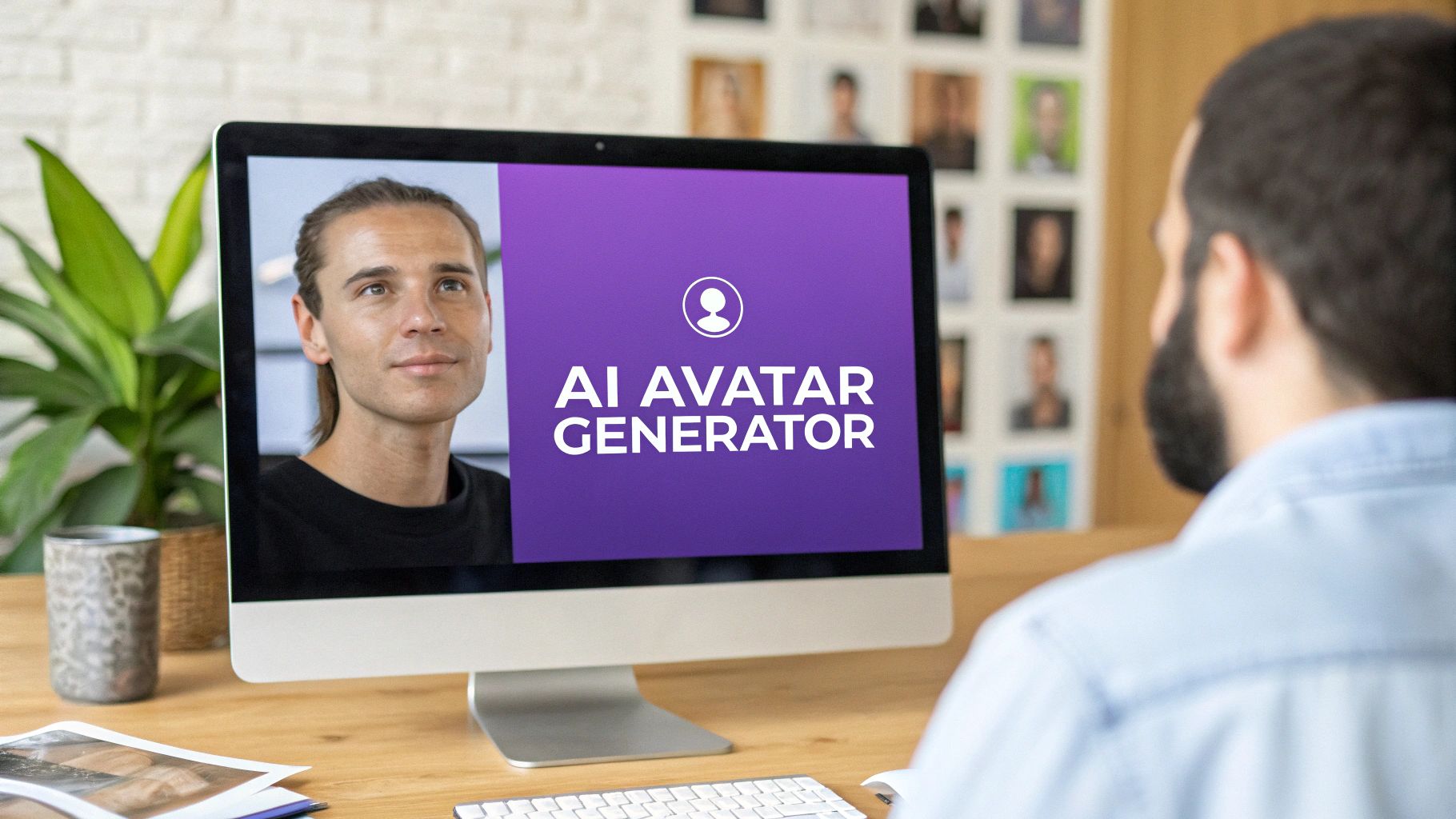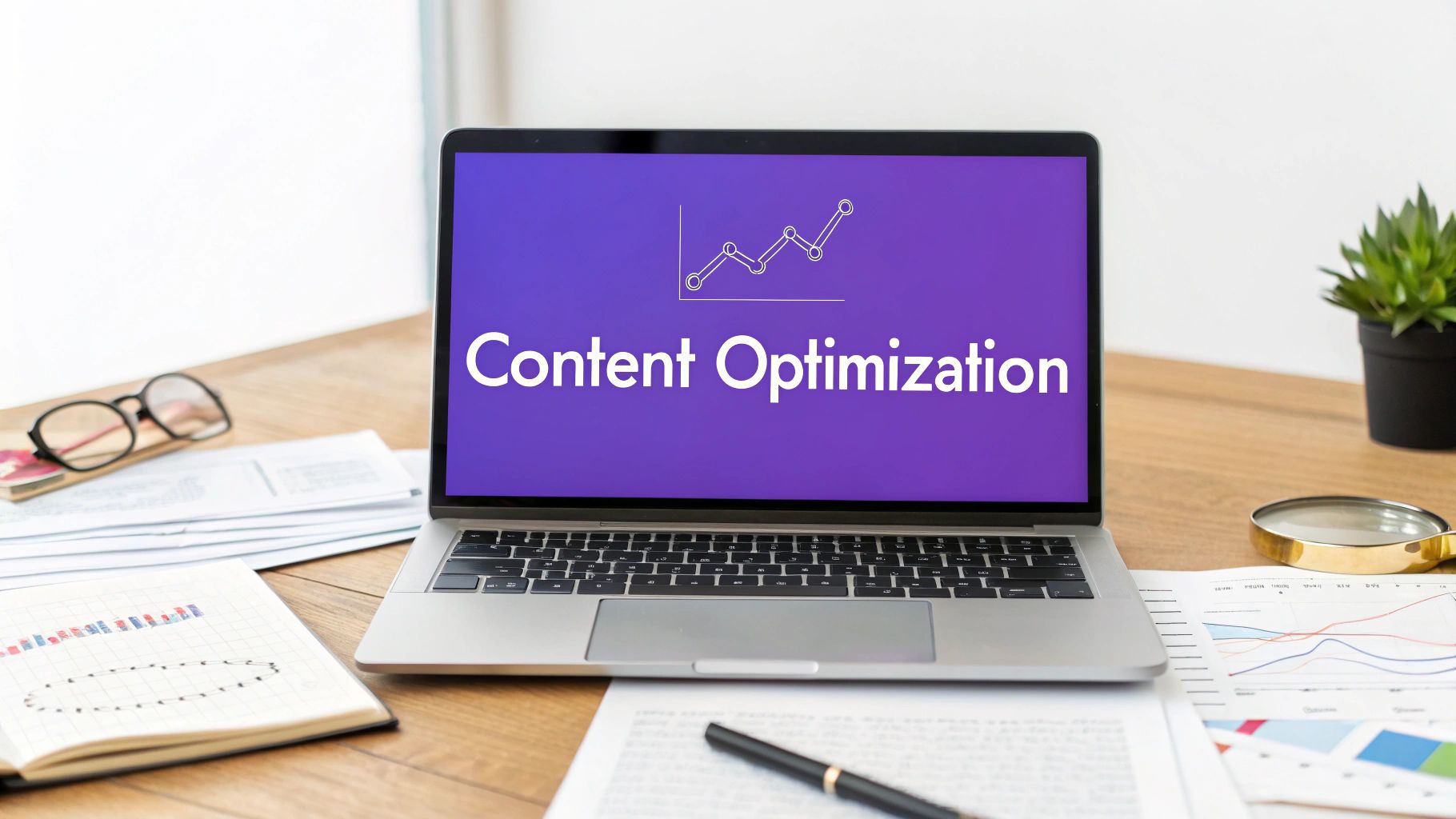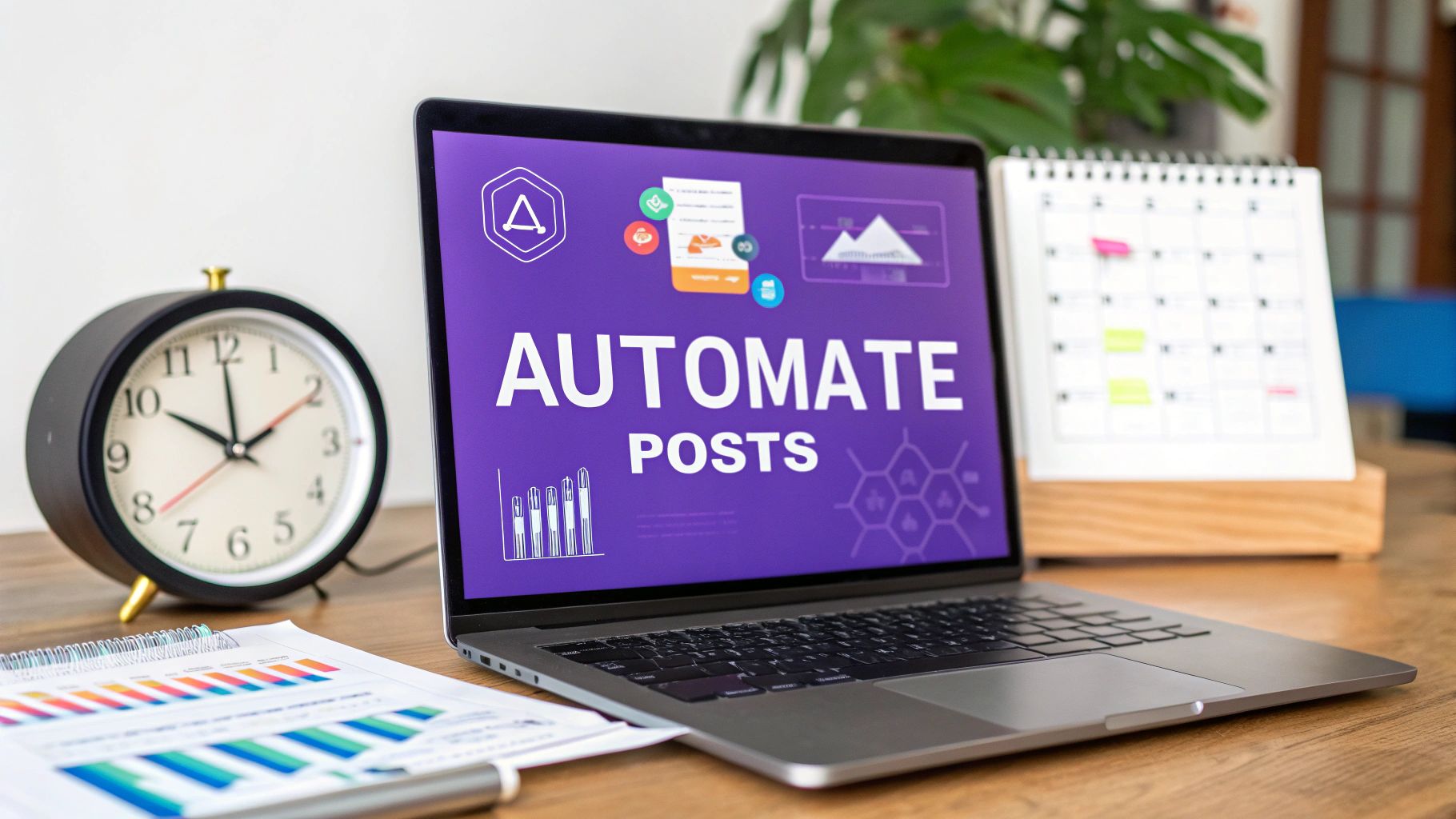How to Identify Target Audience for Real Growth
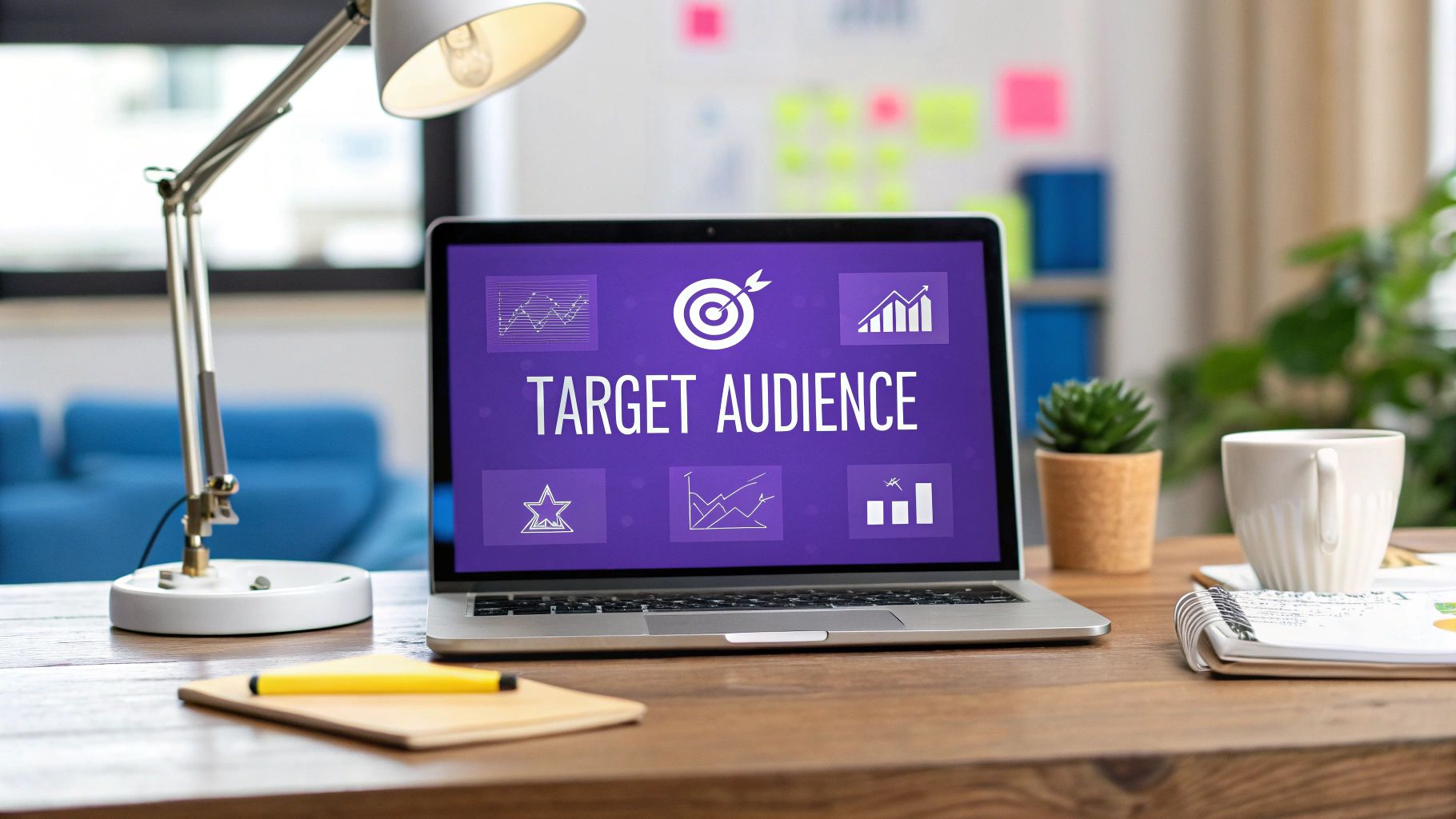
Figuring out your target audience is one of those non-negotiable first steps. It’s all about digging into your current customer base, sizing up the market and your competitors, and then building out detailed buyer personas. When you get this right, your marketing message lands perfectly with the people who are actually likely to become your best customers.
Why Generic Marketing Is a Dead End
Trying to appeal to everyone is a classic rookie mistake, and it’s the fastest way to connect with absolutely no one.
When your message is too broad, it just becomes part of the noise. It’s easy to ignore and even easier to forget. So many brands stumble right here, pouring money into scattered campaigns that barely move the needle. The goal isn’t to limit your reach; it’s to sharpen your focus so you can attract the people who genuinely need what you’re selling.
So, how do the successful brands do it? Their process is usually pretty straightforward but incredibly powerful.
It all starts by looking in the mirror and getting to know your current customers—the ones who already chose you. After that, you zoom out to see what your competitors are doing and where the opportunities are. Finally, you pull all that data together to create buyer personas that guide every single marketing decision you make.
To really dial this in, we've put together a table that breaks down the essential pillars of audience identification.
Key Pillars of Audience Identification
| Pillar | What It Involves | Why It Matters |
|---|---|---|
| Current Customer Research | Analyzing your existing customer data—demographics, behaviors, and feedback. | This is your ground truth. It tells you who already loves what you do. |
| Market & Competitor Analysis | Sizing up market trends and identifying what your competitors are doing right (and wrong). | Helps you find gaps in the market and carve out your unique space. |
| Buyer Persona Creation | Building detailed, semi-fictional profiles of your ideal customers based on real data. | These personas become your North Star for all marketing and product decisions. |
| Validation & Refinement | Testing your assumptions with surveys, interviews, and analytics, then tweaking your personas. | Ensures your strategy is based on facts, not guesswork, and adapts over time. |
Shifting from casting a wide, sloppy net to throwing a well-aimed spear is what separates stagnant brands from growing ones. A solid grasp of Modern B2B Prospecting strategies will give you the clarity you need to build an effective Ideal Customer Profile (ICP) and leave those generic tactics behind for good.
The goal is to stop broadcasting and start connecting. A well-defined audience transforms your marketing from an expense into a strategic investment that delivers measurable returns and fosters genuine brand loyalty.
This sharp focus doesn’t just improve your marketing ROI; it completely changes how your brand is seen in the market. Once you know exactly who you're talking to, you can craft a story that hits home on a much deeper level.
If you want to take this a step further, check out our guide on creating a strong brand positioning framework. It’s the perfect complement to your audience research. It’s the difference between being just another name on a list and becoming the only real choice for your ideal customer.

Find Insights in Your Existing Customer Base
Instead of guessing who your audience might be, start with who they already are. Your most valuable data isn't hiding in some expensive market report; it's right inside your own business, waiting to be uncovered.
Your existing customers chose you for a reason. Figuring out that reason is the first step to finding more people just like them.
Start by digging into your purchase data. Who are your most valuable customers? Look for patterns in how they buy.
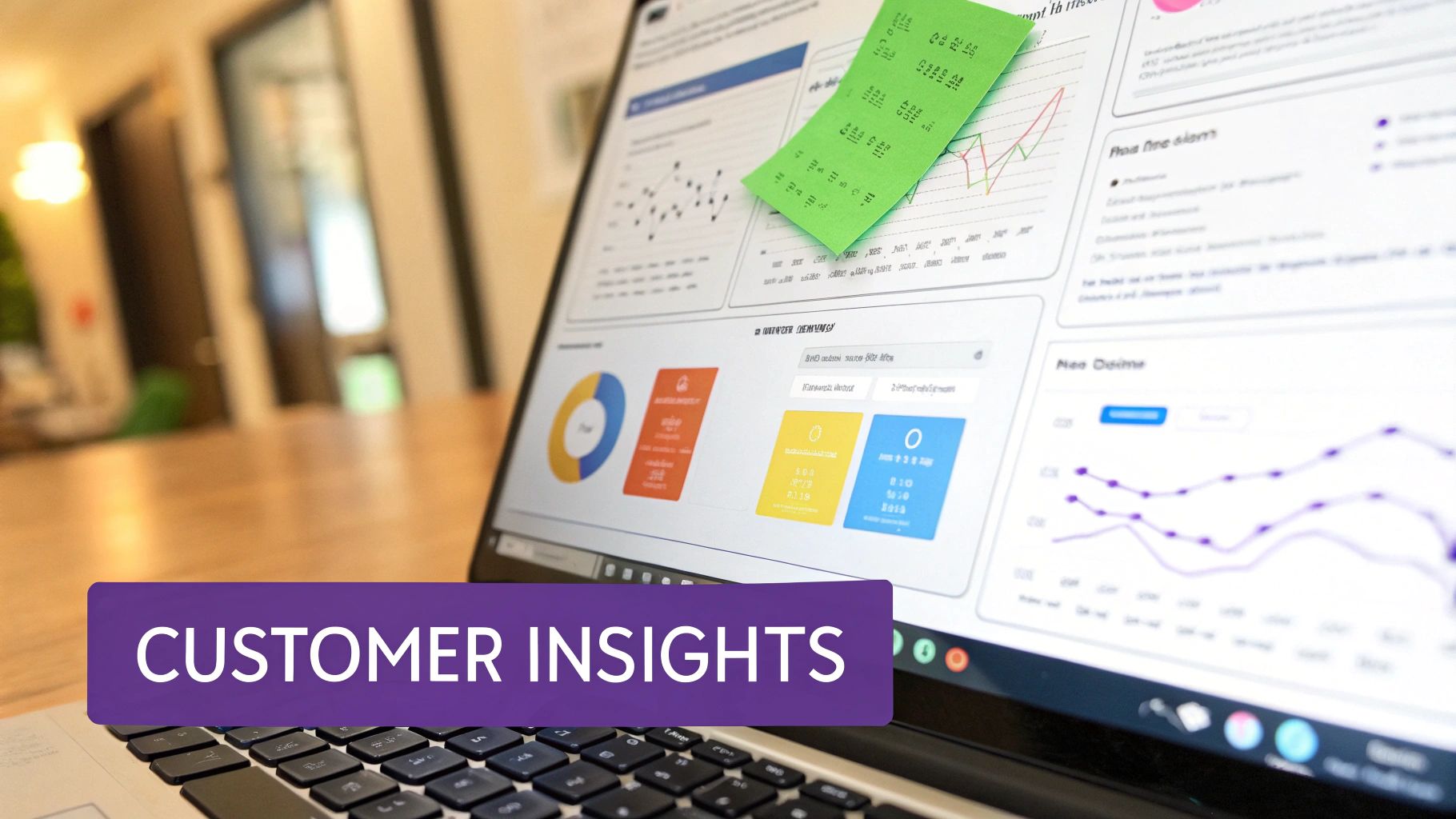
- Top Spenders: Pinpoint the small group of customers who drive a massive chunk of your revenue. What are they consistently buying?
- Repeat Buyers: Who keeps coming back? Analyze their purchase frequency and the products that keep them loyal.
- First-Time Purchases: What specific product or service is the most common entry point for brand-new customers?
This kind of analysis shows you which customer segments are most profitable and gives you clues about what first caught their attention. It’s a core piece of measuring digital marketing effectiveness because it ties your efforts directly to revenue.
Ask the Right Questions
Data tells you the "what," but you need to talk to people to understand the "why." A simple survey can deliver powerful insights that numbers alone just can't provide.
You don’t need some long, complicated questionnaire. Just a few well-aimed questions can get to the heart of what drives your audience.
Pro Tip: When you ask customers for feedback, frame it as a way to help them. A question like, "What was the single biggest challenge you hoped our product would solve?" cuts right to their core pain points and expectations.
Here are a few other powerful questions to ask:
- "What were you using before you found us?" This is great for uncovering your direct and indirect competitors.
- "How would you describe our product to a friend?" This reveals the exact language your customers use.
- "What feature could you not live without?" This helps you zero in on your core value proposition.
By combining purchase history with direct feedback, you stop making assumptions. You start building a foundational profile based on real-world evidence—and it's the most cost-effective way to truly identify your target audience.
Uncover Opportunities with Competitor Research
Understanding your own customers is a great start, but the real magic happens when you start looking at your competitors. This isn't about stealing their playbook. It's about spotting the gaps they've missed and finding the audiences they're completely ignoring.
A good place to start is by looking at who they're talking to. What kind of language are they using in their social media posts, ads, and blog content? This is a dead giveaway for the persona they're trying to attract. For instance, if a rival's content is packed with dense industry jargon and data points, they’re almost certainly targeting seasoned experts. On the flip side, if their tone is simple and aspirational, they're probably aiming for beginners.
To really zero in on what’s working in your niche, it pays to get platform-specific. For example, a deep dive into conducting TikTok competitor analysis can reveal a ton about the messaging and content formats that click with a younger, highly engaged audience.
Analyze Their Audience Demographics
Social media is an absolute goldmine for this kind of detective work. With over 5.24 billion users scattered across different platforms, you have a massive sample size to work with.
But remember, global usage is far from uniform. Factors like geography and age create entirely different user landscapes. Internet penetration in Northern Europe, for example, is over 97.5%, while people aged 15–24 are the most active internet users worldwide. These numbers show why you need to look beyond simple interests and figure out where your potential customers actually hang out online. You can discover more insights about the global digital population on Statista.
This chart breaks down internet users by region, and it tells a pretty interesting story.

While Asia has the highest raw number of users, regions like Europe have much higher penetration rates, which points to a more consistently connected population.
By deconstructing your competitor's audience, you can identify valuable segments they might be neglecting. Perhaps they focus heavily on one gender or age group, leaving a significant opportunity for you to connect with another.
This whole process gives you actionable intelligence that you can plug directly into your own strategy. Our comprehensive competitor analysis framework can walk you through how to structure this research so it's actually useful. The end goal is to build a detailed map of the competitive landscape that shows you exactly where you can win.
Figure Out What Your Audience Wants on Social Media
Thinking every social media platform is the same is a surefire way to burn through your marketing budget. To truly find your audience, you have to get inside their heads and understand why they’re on each specific channel. Someone scrolling LinkedIn for industry news is in a totally different mindset than a hobbyist looking for DIY inspiration on Pinterest.
Your job is to show up where they are, in a way that feels natural and welcome. This means you need to look past basic demographics and start digging into actual behavior.
Dive Into Platform Analytics
Every social platform has a goldmine of built-in analytics that shows you exactly how people engage with your content. These tools are non-negotiable for figuring out what's actually working.
Use them to get answers to some big questions:
- What grabs their attention? Look at which posts get the most likes, comments, and shares. Are there common threads in the topics, formats, or tone?
- What content do they prefer? Do they love your short-form videos, detailed infographics, or are customer stories the real winners?
- When are they online? Find out when your followers are most active. Posting during these peak times gives your content a much better shot at being seen.
This data is like a direct line into your audience’s brain. For a more detailed look, check out our full guide on what social media analytics is and how to put it to work.
Understanding audience behavior on social media isn't just about posting at the right time. It's about decoding the context of each platform to create content that feels native, helpful, and genuinely interesting to the user.
Take Facebook, for instance. It boasts a massive 3.065 billion monthly active users, but there are clear divides between generations. The 25–34 age group is the largest, but you’ll find younger users spending way less time there, opting for platforms like TikTok instead. Getting these platform-specific details right is key to identifying your audience accurately. You can explore detailed social media demographics in this helpful report.
This chart gives you a quick visual breakdown of Facebook's core user base by age.
The data makes it obvious: while Facebook’s reach is huge, its primary audience leans older compared to platforms like TikTok or Instagram. This is the kind of insight that tells you exactly where to invest your time and money based on who you're trying to connect with.
Build Customer Personas That Actually Work
After all that research, you’re sitting on a mountain of data. Now, it’s time to breathe life into it. A customer persona isn’t just some dry list of demographics; it's a semi-fictional profile that tells the story of your ideal customer. Think of it as the shared vision that gets your entire team on the same page.
And this isn't just a marketing exercise. A truly great persona becomes the North Star for your product developers, your sales team, and even your customer service reps. It helps everyone answer the most important questions: What drives this person? What frustrates them? How can we genuinely help them?
From Data Points To A Human Story
The real magic happens when you synthesize your research. You're looking for patterns—those recurring themes that pop up across your surveys, analytics, and competitor insights. The goal is to build a character who feels real because they're based on real data.
For example, your research might start to paint a picture of a key user segment:
- They're women, typically between 28-35 years old.
- Most work as freelance graphic designers.
- A common pain point is struggling with clunky project management tools.
- They’re all over Instagram and Pinterest, hunting for inspiration.
Decoding this kind of audience behavior often starts with a close look at social media engagement. This visual breaks down a simple workflow for turning raw platform analytics into actionable insights you can use.
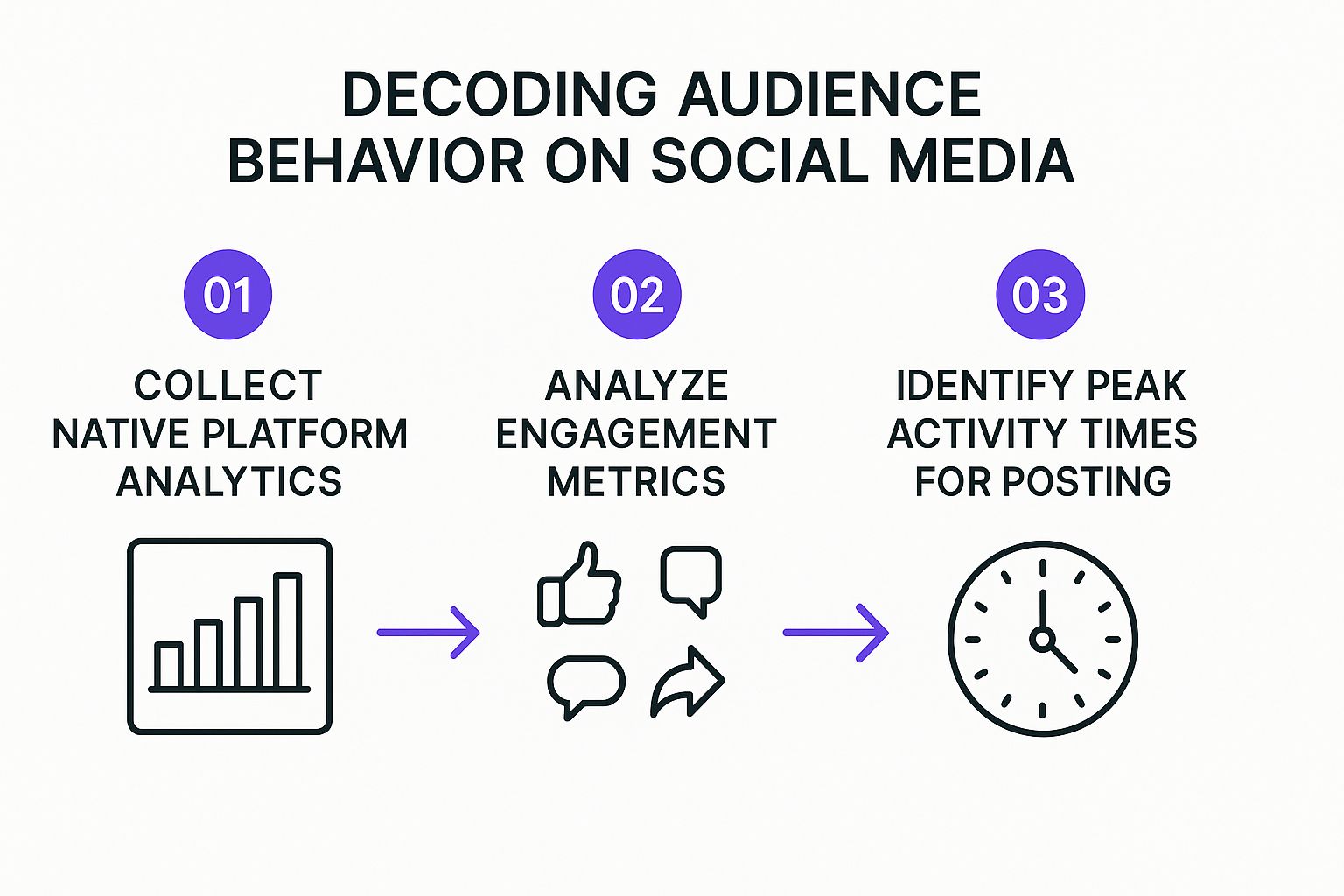
This simple flow shows how data on likes and shares can directly inform your content strategy and posting schedule. It's a critical piece of the puzzle, especially when you consider that the average social media user is active on 6.8 different platforms. With 78% of users preferring to learn about products via short-form video, understanding these platform-specific behaviors is non-negotiable.
It’s no wonder social media ad spend is projected to blow past $276 billion—precise targeting is everything.
A well-crafted persona is a powerful tool for building a comprehensive profile that feels authentic and is easy for your team to reference. The table below outlines the essential components you'll need to create a complete picture.
Essential Components of a Customer Persona
| Component | Example Question to Answer |
|---|---|
| Name & Photo | What’s their name? What do they look like? |
| Demographics | What’s their age, location, income, and education? |
| Job & Seniority | What do they do for a living? What’s their job title? |
| Goals | What are they trying to achieve, both personally and professionally? |
| Frustrations | What are their biggest daily challenges or pain points? |
| Motivations | What drives their decisions? What do they value most? |
| Communication | Where do they get their information? What social media do they use? |
| Quotes | What’s a direct quote that captures their perspective? |
By filling out these details, you move from abstract data to a tangible, human character that your whole team can rally behind.
A great persona feels like a real person your team knows. Give them a name, a job title, and a backstory. This transforms an abstract "target audience" into "Creative Carla," making it so much easier for everyone to stay focused on her specific needs.
Ultimately, this process keeps you from creating products and content for a generic, faceless crowd. For a deeper dive, our complete guide on how to create buyer personas provides templates and more examples to get you started.
Putting Your Audience Research Into Action
Alright, so you’ve done the hard work of figuring out who your target audience is. That's a huge win, but it's only half the battle. The real magic happens when you turn all that research into actions that actually grow your business. This is the moment your customer personas stop being just a document and start becoming your strategic playbook.
With a crystal-clear persona, you can finally sharpen your marketing message. No more generic copy that tries to speak to everyone and ends up connecting with no one. Now you can write ads and social media posts that hit on the exact pain points and ambitions of your ideal customer.
For example, if your persona, “Freelance Frank,” is constantly frustrated with clunky, complicated invoicing software, your messaging can laser-focus on your app’s simplicity and speed. You're not just selling software; you're selling him back his time and sanity.
Aligning Your Strategy With Audience Needs
This isn't just about writing better ads. This research should ripple through every single decision you make—from the platforms you show up on to the features you build next.
- Channel Selection: Does your audience live on LinkedIn, or are they scrolling TikTok? Knowing the answer stops you from throwing your budget into a black hole on platforms where your customers simply aren't hanging out.
- Product Development: Let your personas guide your product roadmap. If you keep hearing that a lack of integration with another popular tool is a major headache, that feature just shot to the top of your priority list.
- Content Creation: What keeps your audience up at night? What questions are they constantly Googling? Create the blog posts, videos, and guides that give them the answers. This is how you stop being just another brand and start becoming a trusted resource.
Here's the thing to remember: audience research isn't a "one and done" project. It's a living, breathing process of listening, testing, and tweaking. Markets change, trends shift, and customer needs evolve—and your understanding of them has to evolve, too.
When you continuously refine your personas with fresh data, you're making sure your business stays relevant and genuinely customer-focused. This creates a powerful cycle: deeper audience understanding leads to better products and smarter marketing, which in turn drives consistent growth.
Think of it as an ongoing conversation with the people who matter most to your success.
Have Questions? We Have Answers
Even with the best game plan, you're bound to hit a few roadblocks when defining your target audience. It happens to everyone. Here are some quick answers to the questions I get asked most often.
What if My Product Appeals to Multiple Audiences?
First off, that's a great problem to have. But it also means you need to get focused, fast. Don't try to be everything to everyone.
The answer is segmentation and prioritization. Instead of creating one generic, watered-down persona, you need to build out distinct profiles for each group. For instance, a project management tool might be a perfect fit for both freelance graphic designers and the owners of small marketing agencies. Those are two very different worlds.
Once you have your segments, it's time to prioritize. Ask yourself:
- Market Size: Which group is actually bigger? Is there more opportunity with one over the other?
- Profitability: Who is willing to pay more for a solution, or who is likely to stick around longer as a customer?
- Urgency of Need: Who feels the pain point you solve most acutely? Who's actively looking for a fix right now?
Pick your winner—the group that scores highest across the board—and aim all your initial marketing efforts there. You can always circle back to your secondary audiences later. A concentrated attack is always better than a scattered one.
How Often Should I Update My Audience Research?
This isn't a "set it and forget it" task. Markets change, people change, and new trends pop up constantly. As a rule of thumb, you should plan on doing a major review of your customer personas once a year.
Think of your audience personas as living, breathing documents. You'll probably make small tweaks every quarter as new campaign data rolls in, but a full, deep-dive review each year is what keeps your strategy sharp and in sync with what your customers actually need.
In between those big annual check-ups, keep your finger on the pulse. This means tuning into social media conversations, keeping an eye on your website analytics, and consistently collecting customer feedback. If you spot a major shift in behavior or a new competitor storms onto the scene, that's your cue to revisit your research ahead of schedule.
What Are the Best Free Tools to Get Started?
You absolutely do not need a massive budget to get powerful insights. There are some fantastic free tools out there that can give you everything you need to build a solid foundation.
- Google Analytics: Jump straight into the 'Demographics' and 'Interests' reports. This will give you a crystal-clear picture of who is already visiting your website. It's a goldmine of information just waiting for you.
- Social Media Analytics: Every single platform—Facebook, Instagram, LinkedIn—has built-in analytics. You can see your followers' age, gender, location, and what content they engage with the most.
- Google Forms: Need direct feedback? This is the easiest way to create and send simple, effective customer surveys. Ask them directly about their pain points and what motivates them.
These three tools alone will give you more than enough raw data to build out your first customer personas without spending a single dollar.
Ready to stop guessing and start connecting? MakerBox uses AI to instantly generate optimized bios, profile photos, and social media content that speaks directly to your ideal audience. Elevate your professional presence in just 30 seconds and see the difference a targeted approach makes. Start transforming your profile with MakerBox today.
